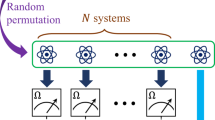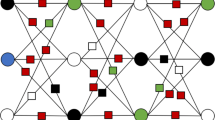Abstract
Recently, Sato et al. proposed an public verifiable blind quantum computation (BQC) protocol by inserting a third-party arbiter. However, it is not true public verifiable in a sense, because the arbiter is determined in advance and participates in the whole process. In this paper, a public verifiable protocol for measurement-only BQC is proposed. The fidelity between arbitrary states and the graph states of 2-colorable graphs is estimated by measuring the entanglement witnesses of the graph states, so as to verify the correctness of the prepared graph states. Compared with the previous protocol, our protocol is public verifiable in the true sense by allowing other random clients to execute the public verification. It also has greater advantages in the efficiency, where the number of local measurements is \(O(n^3\log {n})\) and graph states’ copies is \(O(n^2\log {n})\).





Similar content being viewed by others
Data Availability
Data sharing is not applicable to this article as no datasets were generated or analyzed during the current study.
References
Childs, A.M.: Secure assisted quantum computation. Quantum Inf. Comput. 5(6), 456–466 (2005)
Aharonov, D., Ben-Or, M., Eban, E., Mahadev, U.: Interactive proofs for quantum computations (2017). arXiv:1704.04487
Dupuis, F., Nielsen, J.B., Salvail, L.: Actively secure two-party evaluation of any quantum operation. In: Annual Cryptology Conference, pp. 794–811. Springer
Broadbent, A., Gutoski, G., Stebila, D.: Quantum one-time programs. In: Annual Cryptology Conference, pp. 344–360. Springer
Broadbent, A.: Delegating private quantum computations. Can. J. Phys. 93(9), 941–946 (2015)
Broadbent, A., Fitzsimons, J.F., Kashefi, E.: Universal blind quantum computation. In: 2009 50th Annual IEEE Symposium on Foundations of Computer Science, pp. 517–526. IEEE
Morimae, T., Fujii, K.: Blind quantum computation protocol in which alice only makes measurements. Phys. Rev. A 87(5), 050301 (2013)
Fitzsimons, J.F., Kashefi, E.: Unconditionally verifiable blind quantum computation. Phys. Rev. A 96(1), 012303 (2017)
Morimae, T.: Measurement-only verifiable blind quantum computing with quantum input verification. Phys. Rev. A 94(4), 042301 (2016)
Fujii, K., Hayashi, M.: Verifiable fault tolerance in measurement-based quantum computation. Phys. Rev. A 96(3), 030301 (2017)
Hayashi, M., Hajdušek, M.: Self-guaranteed measurement-based quantum computation. Phys. Rev. A 97(5), 052308 (2018)
Takeuchi, Y., Morimae, T.: Verification of many-qubit states. Phys. Rev. X 8(2), 021060 (2018)
Takeuchi, Y., Mantri, A., Morimae, T., Mizutani, A., Fitzsimons, J.F.: Resource-efficient verification of quantum computing using serfling’s bound. npj Quantum Inf. 5(1), 1–8 (2019)
Hayashi, M., Morimae, T.: Verifiable measurement-only blind quantum computing with stabilizer testing. Phys. Rev. Lett. 115(22), 220502 (2015)
Xu, Q.S., Tan, X.Q., Huang, R., Li, M.Q.: Verification of blind quantum computation with entanglement witnesses. Phys. Rev. A 104(4), 042412 (2021)
Honda, K.: Publicly verifiable blind quantum computation (2016). arXiv:1604.00116
Sato, G., Koshiba, T., Morimae, T.: Arbitrable blind quantum computation. Quantum Inf. Process. 18(12), 1–8 (2019)
Gühne, O., Tóth, G.: Entanglement detection. Phys. Rep. 474(1–6), 1–75 (2009)
Raussendorf, R., Harrington, J., Goyal, K.: Topological fault-tolerance in cluster state quantum computation. New J. Phys. 9(6), 199 (2007)
Shan, R.T., Chen, X.B., Yuan, K.G.: Multi-party blind quantum computation protocol with mutual authentication in network. Sci. China Inf. Sci. 64(6), 1–14 (2021)
Li, Q., Li, Z.L., Chan, W.H., Zhang, S.Y., Liu, C.D.: Blind quantum computation with identity authentication. Phys. Lett. A 382(14), 938–941 (2018)
Gühne, O., Hyllus, P.: Investigating three qubit entanglement with local measurements. Int. J. Theor. Phys. 42(5), 1001–1013 (2003)
Hoeffding, W.: Probability inequalities for sums of bounded random variables. J. Am. Stat. Assoc. 58, 13 (1963)
Lidar, D.A., Brun, T.A.: Quantum Error Correction. Cambridge, UK, Boston (2013)
Barrett, S.D., Stace, T.M.: Fault tolerant quantum computation with very high threshold for loss errors. Phys. Rev. Lett. 105(20), 200502 (2010)
Serfling, R.J.: Probability inequalities for the sum in sampling without replacement. Ann. Stat. 2(1), 39–48 (1974)
Acknowledgements
The authors would like to thank the anonymous reviewers and editors for their comments that improved the quality of this paper. This work is supported by the National Natural Science Foundation of China (62071240), the Innovation Program for Quantum Science and Technology (2021ZD0302902), and the Priority Academic Program Development of Jiangsu Higher Education Institutions (PAPD).
Author information
Authors and Affiliations
Corresponding author
Ethics declarations
Conflict of interest
The authors declare that they have no conflict of interest.
Ethical statement
Articles do not rely on clinical trials.
Human and animal participants
All submitted manuscripts containing research does not involve human participants and/or animal experimentation.
Additional information
Publisher's Note
Springer Nature remains neutral with regard to jurisdictional claims in published maps and institutional affiliations.
Appendix 1 Proof of Theorem 1
Appendix 1 Proof of Theorem 1
In the theorem, (1) has been proved [15] with a condition \(n\ge 6\). Now, we prove (2). At first we introduce the following two probability bounds which will be used in the analysis, where \(\Pr \left( \cdot \right) \) represents the event probability and \(\textrm{E}\left( \cdot \right) \) represents the mathematical expectation:
-
(1)
Serfling’s bound[26] Given a set \(Y = (Y_1,Y_2,...,Y_T )\) of T binary random variables with \(Y_k\in \{0, 1\}\) and two arbitrary positive integers N and K that satisfy \(T = N + K\), select K samples that are distinguished from each other independently, evenly and randomly from Y, and let \(\Pi \) be the set of these samples, \({\overline{\Pi }}=Y-\Pi \), then \(\forall 0<v<1\), we have
$$\begin{aligned} \begin{aligned}&\Pr \left( {\sum \limits _{k \in {{\overline{\Pi }}} } {{Y_k}} \le {N \over K}\sum \limits _{k \in \Pi } {{Y_k}} + Nv} \right) \\&\ge 1 - \exp \left( { - {{2{v^2}N{K^2}} \over {\left( {N + K} \right) \left( {K + 1} \right) }}} \right) . \end{aligned}\end{aligned}$$(A1) -
(2)
Azuma–Hoeffding bound[23] Given independent random variables \({\xi _1},{\xi _2}, \cdots ,{\xi _n}\) where \({\xi _i} \in \left[ {{a_i},{b_i}} \right] , i=1,2,\cdots ,n\), then \(\forall t > 0\), we have
$$\begin{aligned} \begin{aligned}&\Pr \left( {{{{\xi _1} + {\xi _2} + \cdots + {\xi _n}} \over n} - \mathrm{{E} }\left( {{{{\xi _1} + {\xi _2} + \cdots + {\xi _n}} \over n}} \right) \le t} \right) \\&\ge 1 - \exp \left( { - {{2{n^2}{t^2}} \over {\sum \limits _{i = 1}^n {\left( {{b_i} - {a_i}} \right) } }}} \right) . \end{aligned}\end{aligned}$$(A2)
For the first K registers selected, we denote them as \(\Pi ^{(1)}\) and the rest 4K as \({\overline{\Pi }}^{(1)}\). Let \(T = 5K, N=4K, Y_k = \left\{ \begin{matrix}0,M_1^{\varrho '_k} = 1 \\ 1,M_1^{\varrho '_k} = 0 \end{matrix}\right. \), where \(\varrho '_k\) is the state in the k-th register in \(\Pi ^{(1)}\) or \({\overline{\Pi }}^{(1)}\), then we have
by Eq. A1, which means if we perform the j-th measurement on the rest 4K registers, then the upper bound of the number of the registers satisfying \(M_1^\varrho = 0\) (i.e., \({Y_k} = 1\)) in \({{{\overline{\Pi }}} ^{\left( 1 \right) }}\) is \(4\sum \limits _{k \in {\Pi ^{\left( 1 \right) }}} {{Y_k}} + 4Kv\), with the probability on the right side of Eq. A3. Similarly, for the second K registers selected, we denote them as \(\Pi ^{(2)}\) and the rest 3K as \({\overline{\Pi }}^{(2)}\). Let \(T = 4K, N=3K, Y_k = \left\{ \begin{matrix} {0,M_2^{\varrho '_k} = 1}\\ {1,M_2^{\varrho '_k} = 0} \end{matrix} \right. \), where \(\varrho '_k\) is the state in the k-th register in \(\Pi ^{(2)}\) or \({\overline{\Pi }}^{(2)}\), then we have
which means if we perform the j-th measurement on the rest 3K registers, then the upper bound of the number of the registers satisfying \(M_2^\varrho = 0\) in \({{{\overline{\Pi }}} ^{\left( 2 \right) }}\) is \(4\sum \limits _{k \in {\Pi ^{\left( 2 \right) }}} {{Y_k}} + 4Kv\), with the probability on the right side of Eq. A4. In the protocol, any two clients do not trust each other, and thus, it can be considered that the rest 3K registers have not been measured. If we perform the first measurement on the rest 3K registers, there will be \(3K - \left( {4\sum \limits _{k \in {\Pi ^{\left( 1 \right) }}} {{Y_k}} + 4Kv} \right) \) registers satisfying \(M_1^\varrho = 1\) at least, i.e.,
Similarly, we have
Let \(n = 3K, \xi _k = M_1^\varrho \) or \(M_2^\varrho \), then by Eq. A2 we have
By \(Tr\left( {\prod \limits _{i \in {S_1}} {{{{g_i} + I} \over 2}} \varrho } \right) = {\overline{M}} _1^\varrho \) and Eq. A5, we have
and similarly, we have
Therefore, we have
with a probability
where the second inequality in Eq. A11 holds as long as \(K \ge 2\). Obviously, \(\sum \limits _{k \in {\Pi ^{\left( 1 \right) }}} {{Y_k}} = {K_1}\) and \(\sum \limits _{k \in {\Pi ^{\left( 2 \right) }}} {{Y_k}} = {K_2}\) in Eq. A10. To make \(F = \langle G |\rho |G \rangle \) is \(1 - O\left( {{1 \over n}} \right) \), which is high enough, we need that \(v = O\left( {{1 \over n}} \right) , t = O\left( {{1 \over n}} \right) , {4 \over {3K}}\left( {{K_1} + {K_2}} \right) \le {1 \over n}\) which leads to \(F = 1 - O\left( {{1 \over n}} \right) \). Therefore, we set \(v = {{\sqrt{{\lambda _2}} } \over n}, t = {{\sqrt{{\lambda _2}} } \over {\sqrt{6} n}}\), and then consider the acceptance condition \({K_1} + {K_2} \le {{3K} \over {4n}}\) in Algorithm 1; we have
with a probability
To make the probability \(P=1 - O \left( {n ^ {-\lambda }}\right) \) for a constant \(\lambda \), we set \(K = \left\lceil {{n^2}\log n} \right\rceil \), then
which is high enough. The condition for above F, P both to be positive is \({\log _n}4 \le {\lambda _2} \le {{{{\left( {n - 1} \right) }^2}} \over {10}}\), where \(n \ge 5\). When \(n \ge 5\), we have \({n^2} > {{{{\left( {n - 1} \right) }^2}} \over {10}}\), thus \({\lambda _2} < {n^2}\), then \(v = {{\sqrt{{\lambda _2}} } \over n} < 1\). Consider the condition of (1), we have \(n\ge 6\).
Rights and permissions
Springer Nature or its licensor (e.g. a society or other partner) holds exclusive rights to this article under a publishing agreement with the author(s) or other rightsholder(s); author self-archiving of the accepted manuscript version of this article is solely governed by the terms of such publishing agreement and applicable law.
About this article
Cite this article
Liu, WJ., Li, ZX., Li, WB. et al. Public verifiable measurement-only blind quantum computation based on entanglement witnesses. Quantum Inf Process 22, 137 (2023). https://doi.org/10.1007/s11128-023-03859-9
Received:
Accepted:
Published:
DOI: https://doi.org/10.1007/s11128-023-03859-9




